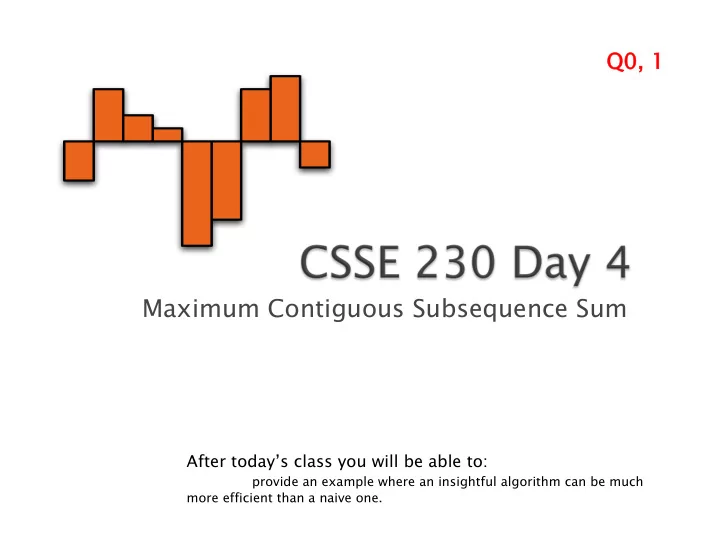

Q0, Q0, 1 1 Maximum Contiguous Subsequence Sum After today’s class you will be able to: provide an example where an insightful algorithm can be much more efficient than a naive one.
Q1 Q1
} Is MCSS θ (n 2 )? ◦ Showing that a problem is Ω (g(n)) is much tougher. How do you prove that it is impossible to solve a problem more quickly than you already can? ◦ Can we find a yet faster algorithm?
A linear algorithm. {-3, 4, 2, 1, -8, -6, 4, 5, -2}
Q2 Q2 } Consider {-3, 4, 2, 1, -8, -6, 4, 5, -2} } Any subsequences you can safely ignore? ◦ Discuss with another student (2 minutes)
Q3 Q3 } We noted that a max-sum sequence A i,j cannot begin with a negative number. } Generalizing this, it cannot begin with a prefix A i,k with k<j whose sum is negative. ◦ Proof by contr tradicti tion. Suppose that A i,j is a max- sum sequence and that S i,k is negative. In that case, a larger max-sum sequence can be created by removing A i,k However, this violates our assumption that A i,j is the largest max-sum sequence.
Q4 Q4 } All contiguous subsequences that border the maximum contiguous subsequence must have negative or zero sums. ◦ Proof by contr tradicti tion. Consider a contiguous subsequence that borders a maximum contiguous subsequence. Suppose it has a positive sum. We can then create a larger max-sum sequence by combining both sequences. This contradicts our assumption of having found a max-sum sequence.
} No max-sum sequence can start from inside a subsequences that has a negative sum and extend beyond it. } In other words, if we find that S i,j is negative, we can skip all sums that begin with any of A i , A i+1 , …, A j . } We can “skip i ahead” to be j+1.
i j becomes < 0
i p-1 p j q becomes < 0
i p-1 p q j becomes < 0
Q5, Q6 Q5, Q6 S i,j is negative. So, skip ahead per Observation 3 Running time is is O (?) How do we know?
} MCSS is O(n)! } Is MCSS Ω (n) and thus θ (n)? ◦ Yes, intuitively: we must at least examine all n elements
} From SVN, checkout MCSSRaces } Study code in MCSS.main() } For each algorithm, how large a sequence can you process on your machine in less than 1 second?
Q11-12 Q11-12 } The first algorithm we think of may be a lot worse than the best one for a problem } Sometimes we need clever ideas to improve it } Showing that the faster code is correct can require some serious thinking } Programming is more about careful consideration than fast typing!
} If GM had kept up with technology like the computer industry has, we would all be driving $25 cars that got 1000 miles to the gallon. - Bill Gates } If the automobile had followed the same development cycle as the computer, a Rolls- Royce would today cost $100, get a million miles per gallon, and explode once a year, killing everyone inside. - Robert X. Cringely
A preview of Abstract Data Types and Java Collections This week’s major program
Q7-8 Q7-8 An exercise in implementing your own growable circular Queue: 1. Grow it as needed (like day 1 exercise) 2. Wrap-around the array indices for more efficient dequeuing Discuss Stacks as a warmup (push, pop), then ideas for Queues (enqueue, dequeue) Analyze implementation choices for Queues – much more interesting than stacks!
Q9 Q9 An exercise in writing cool algorithms that evaluate mathematical expressions: Infix: 6 + 7 * 8 Postfix: 6 7 8 * + Both using sta tacks.
} Plan when you'll be working } Review the pair programming video as needed } Check out the code and read the specification together
Recommend
More recommend